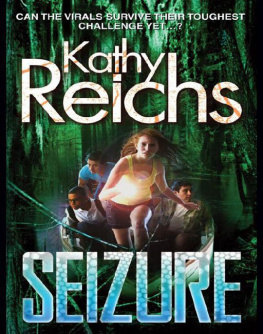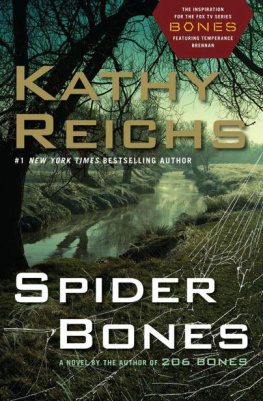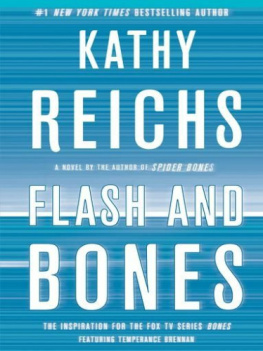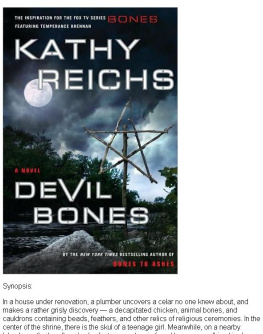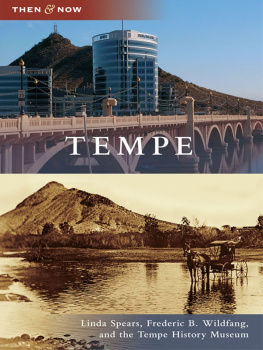
BREAK NO BONES
By
KATHY REICHS
The ninth book in the Temperance Brennan series
Copyright Temperance Brennan L.P. 2006
ISBN 0434010421 (hardback)
In loving memory of Arvils Reichs
February 9, 1949February 23, 2006
Dusi Saldi
NEVER FAILS. YOU'RE WRAPPING UP THE OPERATION WHEN SOMEONE blunders onto the season's big score.
OK. I'm exaggerating. But it's damn close to what happened. And the final outcome was far more disturbing than any last-minute discovery of a potsherd or hearth.
It was May 18, the second-to-the-last day of the archaeological field school. I had twenty students digging a site on Dewees, a barrier island north of Charleston, South Carolina.
I also had a journalist. With the IQ of plankton.
"Sixteen bodies?" Plankton puled a spiral notebook as his brain strobed visions of Dahmer and Bundy. "Vics ID'd?"
"The graves are prehistoric."
Two eyes roled up, narrowed under puffy lids. "Old Indians?"
"Native Americans."
"They got me covering dead Indians?" No political correctness prize for this guy.
"They?" Icy.
"The Moultrie News. The East Cooper community paper."
Charleston, as Rhett told Scarlett, is a city marked by the genial grace of days gone by. Its heart is the Peninsula, a district of antebelum homes, cobbled streets, and outdoor markets bounded by the Ashley and Cooper rivers. Charlestonians define their turf by these waterways. Neighborhoods are referred to as "West Ashley" or "East Cooper," the latter including Mount Pleasant, and three islands, Sulivan's, the Isle of Palms, and Dewees. I assumed plankton's paper covered that beat.
"And you are?" I asked.
"Homer Winborne."
With his five-o'clock shadow and fast food paunch, the guy looked more like Homer Simpson.
"We're busy here, Mr. Winborne."
Winborne ignored that. "Isn't it ilegal?"
"We have a permit. The island's being developed, and this little patch is slated for home sites."
"Why bother?" Sweat soaked Winborne's hairline. When he reached for a hanky, I noticed a tick cruising his colar.
"I'm an anthropologist on faculty at the University of North Carolina at Charlotte. My students and I are here at the request of the state."
Though the first bit was true, the back end was a stretch. Actualy, it happened like this.
UNCC's New World archaeologist normaly conducted a student excavation during the short presummer term each May. In late March of this year, the lady had announced her acceptance of a position at Purdue. Busy sending out resumes throughout the winter, she'd ignored the field school. Sayonara. No instructor. No site.
Though my specialty is forensics, and I now work with the dead sent to coroners and medical examiners, my graduate training and early professional career were devoted to the not so recently deceased. For my doctoral research I'd examined thousands of prehistoric skeletons recovered from North American burial mounds.
The field school is one of the Anthropology Department's most popular courses, and, as usual, was enroled to capacity. My coleague's unexpected departure sent the chair into a panic. He begged that I take over. The students were counting on it! A return to my roots! Two weeks at the beach! Extra pay! I thought he was going to throw in a Buick.
I'd suggested Dan Jaffer, a bioarchaeologist and my professional counterpart with the medical examiner/coroner system in the great Palmetto State to our south. I pleaded possible cases at the ME office in Charlotte, or at the Laboratoire de sciences judiciaires et de mdecine legale in Montreal, the two agencies for which I regularly consult.
The chair gave it a shot. Good idea, bad timing. Dan Jaffer was on his way to Iraq.
I'd contacted Jaffer and he'd suggested Dewees as an excavation possibility. A burial ground was slated for destruction, and he'd been trying to forestal the buldozers until the site's significance could be ascertained. Predictably, the developer was ignoring his requests.
I'd contacted the Office of the State Archaeologist in Columbia, and on Dan's recommendation they'd accepted my offer to dig some test trenches, thereby greatly displeasing the developer.
And here I was. With twenty undergraduates. And, on our thirteenth and penultimate day, plankton-brain.
My patience was fraying like an overused rope.
"Name?" Winborne might have been asking about grass seed.
I fought back the urge to walk away. Give him what he wants, I told myself. He'l leave. Or, with luck, die from the heat.
"Temperance Brennan."
"Temperance?" Amused.
"Yes, Homer."
Winborne shrugged. "Don't hear that name so much."
"I'm caled Tempe."
"Like the town in Utah."
"Arizona."
"Right. What kind of Indians?"
"Probably Sewee."
"How'd you know stuff was here?"
"Through a coleague at USC-Columbia."
"How'd he know?"
"He spotted smal mounds while doing a survey after the news of an impending development was announced."
Winborne took a moment to make notes in his spiral. Or maybe he was buying time to come up with his idea of an insightful question. In the distance I could hear student chatter and the clatter of buckets. Overhead, a gul cawed and another answered.
"Mounds?" No one was going to short-list this guy for a Pulitzer.
"Folowing closure of the graves, shels and sand were heaped on top."
"What's the point in digging them up?"
That was it. I hit the little cretin with the interview terminator. Jargon.
"Burial customs aren't wel known for aboriginal Southeastern coastal populations, and this site could substantiate or refute ethnohistoric accounts. Many anthropologists believe the Sewee were part of the Cusabo group. According to some sources, Cusabo funerary practices involved defleshing of the corpse, then placement of the bones in bundles or boxes. Others describe the scaffolding of bodies to alow decomposition prior to burial in common graves."
"Holy crap. That's gross."
"More so than draining the blood from a corpse and replacing it with chemical preservatives, injecting waxes and perfumes and applying makeup to simulate life, then interring in airtight coffins and vaults to forestal decay?"
Winborne looked at me as though I'd spoken Sanskrit. "Who does that?"
"We do."
"So what are you finding?"
"Bones."
"Just bones?" The tick was now crawling up Winborne's neck. Give a heads-up? Screw it. The guy was irritating as hel.
I launched into my standard cop and coroner spiel. "The skeleton paints a story of an individual. Sex. Age. Height. Ancestry. In certain cases, medical history or manner of death." Pointedly glancing at my watch, I folowed with my archaeological shtick. "Ancient bones are a source of information on extinct populations. How people lived, how they died, what they ate, what diseases they suffered"
Winborne's gaze drifted over my shoulder. I turned.
Topher Burgess was approaching, various forms of organic and inorganic debris pasted to his sunburned torso. Short and plump, with knit cap, wire rims, and muttonchop sideburns, the kid reminded me of an undergraduate Smee.
"Odd one intruding into three-east."
I waited, but Topher didn't elaborate. Not surprising. On exams, Topher's essays often consisted of single-sentence answers. Ilustrated.
"Odd?" I coaxed.
"It's articulated."
A complete sentence. Gratifying, but not enlightening. I curled my fingers in a "give me more" gesture.
"We're thinking intrusive." Topher shifted his weight from one bare foot to another. It was a lot to shift.
Next page

